Suresh Kumar Chaudhary
Department of Science and Technology, Himalayan Institute of Science and Technology, Kathmandu, Nepal
Correspondence to: Suresh Kumar Chaudhary, Department of Science and Technology, Himalayan Institute of Science and Technology, Kathmandu, Nepal.
| Email: |  |
Copyright © 2023 The Author(s). Published by Scientific & Academic Publishing.
This work is licensed under the Creative Commons Attribution International License (CC BY).
http://creativecommons.org/licenses/by/4.0/

Abstract
Project delay is an issue of major concern as Nepalese construction industry are experiencing a wide spread of delays. The aim of this research was to access the key factors causing delays and their effects on RCC building construction projects in malkot of kalikot district. Reinforced Cement Concrete (R.C.C) is a composite material consisting of concrete and steel. Malkot is a high mountainous and a remote area of kalikot district. There is no any road track to reach Malkot from Karnali Highway. For this numerous research paper were analyzed and case study of different ongoing construction sites of malkot and kalikot district were carried out. Methodology was designed as per requirement of the study. The primary data were collected by medium of structured interviews, Questionnaire survey and observation of construction sites. The questions were categorized into four main groups related to designer (engineer), contractor, client and external factors. Questionnaire survey were conducted across stakeholders that included among others; designer (engineer), contractors and clients on four selected building projects to gather their views on causes of delay in delivery of projects. This research analyzed the causes of delay for remote areas and accessed their impacts on delay using relative importance index (RII) for each related responses for each category. The study concluded that external factors category had the highest impact (RII=0.909), followed by client related (RII=0.905), then contractor related (RII=0.860) and designer (engineer) related (RII=0.827) exhibited the least impact. Identification of key delay impact factors and its successful management can help to avoid extra costs and deliver building projects on time especially in a high mountainous and remote areas.
Keywords:
RCC Building Construction, Delays, Geographical remoteness, External Factors of Delay, Relative Importance Index
Cite this paper: Suresh Kumar Chaudhary, An Analysis of the Key Factors Causing Delays on RCC Building Construction Projects in “Malkot Village” Kalikot District, Nepal, Journal of Civil Engineering Research, Vol. 13 No. 1, 2023, pp. 1-11. doi: 10.5923/j.jce.20231301.01.
1. Introduction
Building construction projects are relatively complex and expensive endeavors that take a long time from start of the investment decision to the delivery of the end product (Komurlu & Arditi, 2021). The Success of a building construction project depends on scope, time and budget (Komurlu & Arditi, 2021). However, many project experience extensive delays and thereby exceed initial time and cost estimates (Ahmed, 2016). Delay is a chronic and real-world managerial problematic situation (Jashaami, 2021). In construction, delay could be defined as the time overrun either beyond completion date specified in a contract or beyond the date that the parties agreed upon for delivery of a project (Shahsavand, Marefat, & Parchamijalal, 2018). Delay can cause such predicaments as increased construction costs, loss of profits due to low productivity, lawsuits between contracting parties and contract termination (Yap, Goay, Woon, & Skitmore, 2021).A number of studies have been conducted in regard to delays in construction projects for decades and identified various factors that are responsible for delays in delivering construction projects globally. Several studies have identified that incomplete drawing, inadequate experience of consultant (Designer), rigidity of designer, design error by designer, late issuance of design and drawings by designer, insufficient communication between client and designer were the major causes of designer related delay factors. Previous studies identified that price escalation, labor strikes, government regulations, slow permit by government, changes in government regulations and civil war were the major causes which is related to external conditions and factors. Similarly, client’s cash flow problems, variation orders and slow decision making were found critical delay factors of client related (Muhwezi, Acai, & Otim, 2014). Similarly, inadequate supply of materials by contractor, lack of high technology mechanical equipment, frequent changes of sub-contractor, poor qualifications of contractor technical staff, improper project planning by contractor were found major causes of contractor related delay factors (Aziz, 2013). The above mentioned causes of different related groups are common and still exist for general cases but past researches were not found fully sufficient that reflects delay causes for high mountainous and remote areas like Malkot as it is situated at a minimum level of 728 to maximum 4790 meters height from sea level having unique geology, elevations, slope characteristics (stability) and no transportation facility at all (kalikot, 2008). For instance, it took 40 months to complete residential house of Ganesh Budha (a local resident of Malkot village) instead of original 10 months representing a total delay period of 30 months. This research have identified some missing external factors and other related categories factors which are very important, not found in previous researches and needs proper and successful management. This research have identified that external factors (RII= 0.909 – 0.855) are major causes of delay in comparison of factors related to client, contractor and designer for location of Malkot. Huge gap is found between design and construction process in this research. The aim of this research is to identify and analyze major potential key delay factors with their impact value related to all categories (client, contractor, designer and external). Relative importance index (RII) has been used to find impact value for each responses. Identification of high impact delay factors and their management leads project towards success in terms of time, budget and stakeholder’s satisfaction.
2. Materials and Methods
2.1. Study Area
The research was conducted in Malkot village of Kalikot district. Four private residential RCC buildings were selected for the research. Availability of on-going building construction projects, easy accessibility of client and contractors especially in village, unique geology of location, differing site conditions, slope characteristics of site, soil instability, transportation adversity were the main reasons to choice the area to know various perception and impacts regarding all delay factors.
2.2. Methodology
Research methodology is the path through which researchers need to conduct their research. It shows the path through which these researchers formulate their problem and objective and present their result from the data obtained during the study period (Suresh Kumar Chaudhary, 2022). The systematic method used to address the research question or problem is research methodology. Methodology was designed to extract primary relevant information from clients, contractors and designers. A study of this nature requires the use of the appropriate tools for data collection, which in most cases is the likert type questionnaire. Primary sources of data were collected using structured questionnaires on a 5- point likert scale. The questionnaires were directly distributed to respondents. Respondents were requested to indicate which factors they considered to have significant effects on delay of projects based on their experience and other factors. The questionnaire adopted a 5-point likert scale ranging from 5 (strongly agree) to 1 (strongly disagree), the higher the number, the greater the influence on schedule delays. The population size of the study is 8 residential RCC buildings which are currently under construction. In the selected sample of 4 residential RCC building construction sites, there were 16 contractors, 8 designers and 4 clients at the time of recent survey 2022. The primary data were more reliable and have more confidence level of decision-making with the trusted analysis having direct intact with occurrence of the events (Suresh Kumar Chaudhary, 2022). The questionnaire is composed for each categories separately and distributed to relevant respondents. 13 questions were distributed to client, contractor and designer to know their perception about external factors which causes delay in construction process.8 questions were distributed to clients and contractors to know the perception of them about designer related delay causes. Similaraly, 18 questions were distributed to clients and designer to know the perception of them about contractor related delay causes. Finally, 8 questions were distributed to designer and contractor to know the perception of them about clients related delay causes. 12 number of contractors were sample size for 16 numbers of Population size of contractors. 3 numbers of client were sample size for 4 numbers of population size of client. Similarly, 7 numbers of designer were sample size for 8 numbers of population size of designer. The sample selection is based on purposive sampling method. Slovin’s formulae is used to find sample size from population size. | (1) |
Where, n = sample size, N = population size and e = margin of error (taken as 10%)Table 1. Population size and Sample size
 |
| |
|
Table 2. Respondent’s Table
 |
| |
|
2.3. Data Analysis
Relative Importance Index (RII) was used to evaluate attitude by using the eqn (2) and the results of analysis were presented. | (2) |
Here,W= weighting of each factor by respondents from 1 to 5, where “1” is for “strongly disagree” and “5” for “strongly agree”, A= highest weight (5), N= total number of respondents.
3. Results
Table 3. Overall delay causes with relative importance index and ranking in descending order
 |
| |
|
Table 4. External Factors
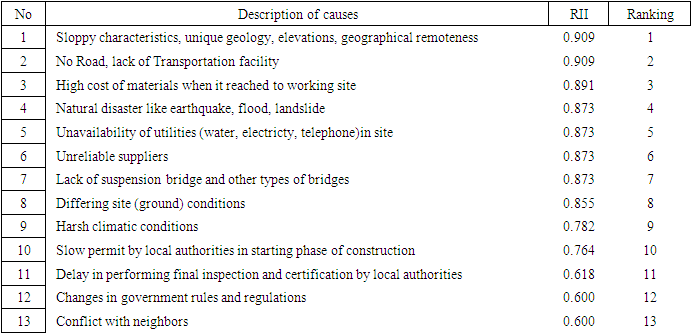 |
| |
|
Table 5. Client Related Category
 |
| |
|
Table 6. Contractor Related Category
 |
| |
|
Table 7. Designer (Engineer, Draftsman) Related Category
 |
| |
|
4. Discussion
A construction project is commonly acknowledged as successful where it is completed on time, within budget in accordance with specification and to stakeholder’s satisfaction (Aziz, 2013). The delay in construction projects has a significant impact and consequences on the organizations in terms of profitability and competitiveness in the market (Alali, Suliman, & Al-Shafie, 2022). It is nature of construction projects to be limited by time and cost. Construction projects has always been plagued by delay. Clients, contractors, designers are the main stakeholders and they were found responsible for delay causes in many ways.
4.1. External Factors Related Delay Causes
The research undertaken established that external factors related delay causes had highest impact in running building construction projects in Malkot with relative importance index (RII=0.909). The research revealed that sloppy characteristics, unique geology, elevations, geographical remoteness (RII=0.909), lack of transportation facility (RII=0.909), high cost of material when it reaches to construction site (RII=0.891), natural disaster like landslide, flood, earthquake, soil erosion (RII=0.873), unavailability of utilities (water, electricity, telephone) in site (RII= 0.873), unreliable suppliers (RII=0.873), lack of suspension and other types of bridge (0.873), harsh climatic conditions (RII=0.782) and differing site (ground) conditions (RII=0.855) are very critical external factors causing delays in construction works in Malkot. Consequently, the research revealed that slow permit by local authorities (RII=0.764), delay in performing final inspection and certification by local authorities (RII=0.618), changes in government rules and regulations (RII=0.600) and conflict with neighbours (RII=0.600) have less effect on causing delays in building construction projects. From the summary of results in Table 3, it can be observed that external factors related delay causes are the major primary and vital causes of delays in comparison to client, contractor and designer related delay causes for construction works in Malkot village. As mentioned above, Malkot village lies in high mountainous physiographic region and this region consists of sloping and south east faced mountains covered with forest. Steeper slope with rocky exposures are usually covered with thin layer of colluvial soil and they are found susceptible to soil creeping, sheet, rill and gully erosion which causes delays in construction works in this area. Lack of transportation facility is one of the most critical factor causing delays for this region. Malkot village is nearly 8 Km from Khulalu Bazar (Karnali Highway) (Fig 1). There is no any road track to reach Malkot from Karnali Highway (Fig 2). There is no any suspension bridge and other types of bridges across the river which really creates big problem to pass the rivers in rainy seasons. The main means of transportation in the area is animal back and porters are also employed for transportation of construction materials which is very risky and very costly (Fig 3). Suppliers can’t distribute and deliver material on time which causes delay in construction work in this area. Similaraly, heavy rainfall from July to October is also main cause of delay in this area. There is no electricity facility in Malkot village which also causes delay in construction works. The responses obtained from the respondents related to external factor delay causes are very relevant. The stakeholders have no control over some external factors, although ample strategies must be put in place to address the challenges in the event of occurrence.
4.2. Client Related Delay Causes
The research undertaken established that Clients related delay causes had also high impact in running building construction projects in Malkot after external factors impact with relative importance index (RII=0.905). The research revealed that delay in making progress payment by client (RII=0.905), design changes during construction by client (RII=0.853) and Changes made in material and specifications during construction by client (RII=0.821) are very critical client related delay causes in construction works in Malkot. Consequently, the research revealed that Slow decision made by client (RII=0.716), Unrealistic time schedule imposed in contract (RII=0.674), Delay in site delivery (RII=0.663), Conflict between joint ownership project (0.653) and Delay in approving design documents (RII=0.611) have less effect on causing delays in building construction projects. Contractors cannot run building construction projects smoothly when progress payment is delayed by client as contractors have to manage everything like materials, labors and sub-contractors too. Therefore, timely progress payment is very important to run the construction process and works smoothly. Generally, it is not allowed to change designs and specifications during construction stage as this step changes construction schedules and total project costs which causes delays. Therefore, timely progress payment and working smoothly according to specified design drawings is very essential to complete construction works on time.
4.3. Contractor Related Delay Causes
From the summary of results in Table 6, it can be observed that lack of contractor financing (RII=0.860), late delivery, supply of materials(RII=0.840), slow mobilization of materials and labours (RII=0.800), Escalation of material prices (RII=0.780), low productivity and efficiency of equipment (RII=0.780), shortage of adequate material, equipment and labor (RII=0.760) and frequent changes of subcontractor (RII=0.760) are critical causes of delay in construction works in Malkot village which is related to contractor. The research however revealed that conflicts between main and sub-contractors (RII=0.740), site accidents due to lack of safety measures (RII=0.740), improper project planning by contractor (RII=0.720), improper construction method implemented by contractor (RII=0.700), poor site supervision by contractor (RII=0.700), re-work due to error during construction (RII=0.680), poor qualification of contractors related technical staff and labours (RII=0.660), conflicts in sub-contractor schedule (RII=0.640), poor communication between client and contractor (RII=0.640), absenteeism of labors and technical staff (RII=0.640) and poor quality of materials (RII=0.620) are also causes of delay but these have less significance. There are total 15,000 construction firms registered as class A,B,C and D in Nepal according to Federation of Contractors’ Association of Nepal (FCAN) (Nepal, 2020). Contractors finance is very important to run the construction works smoothly. Lack of financing effects in procurement of materials, managing smooth mobilization of labor and sub-contractors, hence causing delays in construction works. Improper construction methods implemented contractor creates an environment of re-work which causes increase in cost and delays in work too. Contractor must have knowledge of project plan, resource plan, financial plan, quality plan, risk plan and also procurement plan so that they can manage everything in time and run construction works smoothly and can complete the construction works in time without any delay.
4.4. Designer (Engineer, Draftsman) Related Delay Causes
The research undertaken established that Designer related delay causes had least impact in running building construction projects in Malkot than others factors with relative importance index (RII=0.827). The research revealed that insufficient survey, feasibility study and planning of site before design by designer (RII=0.827), poor communication and coordination between designer and client (RII=0.813) and not providing design in fixed time (RII=0.800) are the major causes of delay related to designer. The research however revealed that design inadequate experience of designer (RII=0.773), re-work due to design error (RII=0.773), design error made by designer (RII=0.720), incomplete and unclear drawing provided by designer (0.693) and mis-understanding of client’s requirement have less impact in comparison of other factors. Complete feasibility study, complete perfect survey and proper planning before design process is very essential for designer as it helps designer to design perfect drawings and accurate cost estimates if necessary. Insufficient survey, poor feasibility study and improper site planning leads towards design error which causes delay in construction process.
5. Conclusions
An engineering project is combination of design and construction phase. Delays in construction projects are a widely researched area for which more researchers are constantly being carried out. Various researches were carried out previously by researchers of Nepal regarding delay factors in construction works but scenarios are completely different for construction works of remote areas like Malkot than city area of Nepal. Due to wide coverage of construction projects in terms of size, type, geography, there is still need to investigate and analyze the causes and assess the effect of delays on various construction projects at various levels. For this reason, this research is carried out to address inefficiencies in the construction works in remote area with high geographical disturbances and different restrictions. The effect of construction delays carries a rippling effect on the contracting parties. Delays can be avoided or minimized when their causes are effectively identified and analyzed. In this research, external factors were found major reasons for construction delay than other factors. unavaiability of basic utilities like water, electricity, lack of transportation route, sloppy characteristics of land, instability of soil, low bearing capacity of soil, natural disaster like landslide, soil erosion, high material and labor cost because of adversity of transportation, unreliable suppliers are found major factors for construction delay. Similaraly, delay in progress payment by client, poor project financing by contractor and insufficient survey and feasibility study of working site by designer are found other major reasons for construction works. Since, no one have control over nature but risks can be minimized by applying different procedures. Based on the identified impacts, their nature extent and magnitude, the mitigation and monitoring prescription is found necessary which helps to avoid delays in construction works. Alternative modes of transportation is found very essential, especially for these types of area and locations. It can be referred to as the other modes of transportation network to be built which includes trails, ropeways and other modes of transportation. These alternative modes of transportation save considerable travel time and helps to avoid delay. This research strongly suggests to schedule construction period from December to June which is the most suitable choice of the construction of various projects because July to October is heavy rainy season for this area. Clients have choice to select experience designers so that design error can be avoided and hence delay can be avoided to some extent. This research concludes that project financing problems occurs by contractor because contractors are very poor in management plan of time, risk, cost, issue, quality and procurement. Therefore, all these critical causes of delay must be analyzed minutely and must implement practical approach relevant to location to complete the construction works on time within specified budget.
6. Recommendations
According to the above mentioned findings, following points can be recommended in order to minimize and control delays in construction projects:1. Local authorities and Central government must pay attention towards alternative modes of transportation like trails and ropeways.2. Local authorities and Central government must pay attention towards management of basic utilities like water, electricity and telephone services.3. Construction schedule period must be selected from December to June.4. Designer must give consideration to the potential effect of seismic shaking, soil instability, landslide effect, soil erosion effects when designing structures.5. Any design error made by designer must be immediately rectified to avoid delays in the progress of work.6. Designers (Engineers) must carry out sufficient survey, feasibility study before design process. 7. Contractors should ensure that they have enough cash flow to execute the construction works.8. Contractors should pay more attention to prepare effective planning and scheduling.9. Main contractor should avoid higher degree of sub-contracting as it may lead to high risk of delays.10. Contractors should pay more attention to deliver the construction equipment and materials on site on time.11. Contractors should focus on all risk management process rather than only risk assessment process.12. Client must pay progress payments on time.13. Proper and regular communication is must between designer, client and contractor. 14. All the stakeholders should work together and ensure that all disputes are mitigated during the construction period.Finally, the findings of this research can be used in various types of construction projects, especially of remote areas in developing countries like Nepal.
Appendix A
SET A: Questionnaire for Contractor, Client and Designer (22 respondents)
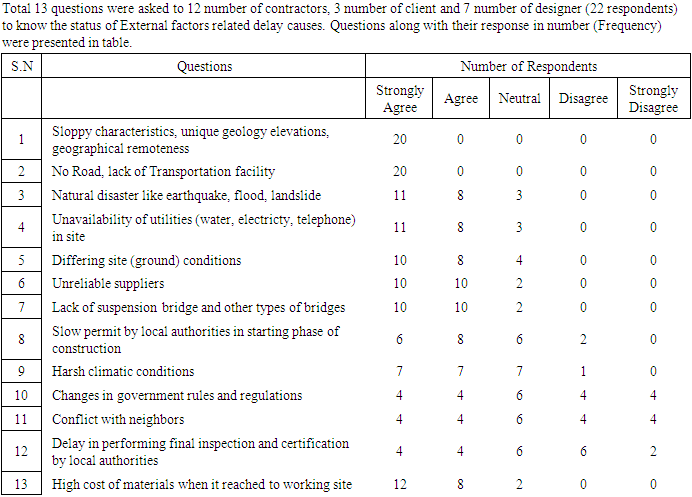 |
| |
|
Appendix B
SET B: Questionnaire for Contractor and Designer (19 respondents)
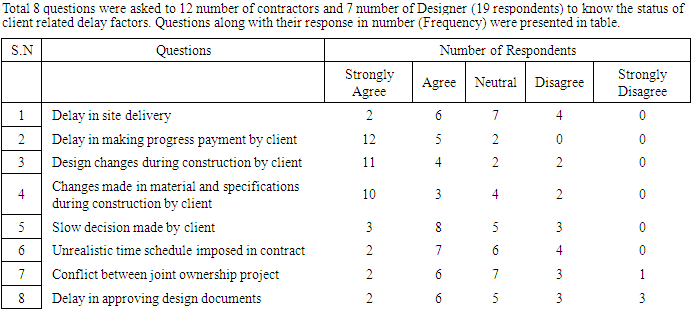 |
| |
|
Appendix C
SET C: Questionnaire for Client and Designer (10 respondents)
 |
| |
|
Appendix D
SET D: Questionnaire for Contractor and client (15 respondents)
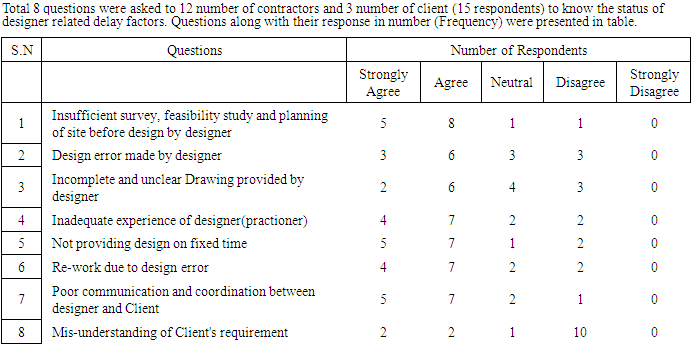 |
| |
|
Appendix E
Photographs of project area | Figure 1. Starting point Khulalu road near Rahagadh khola, Khulalu |
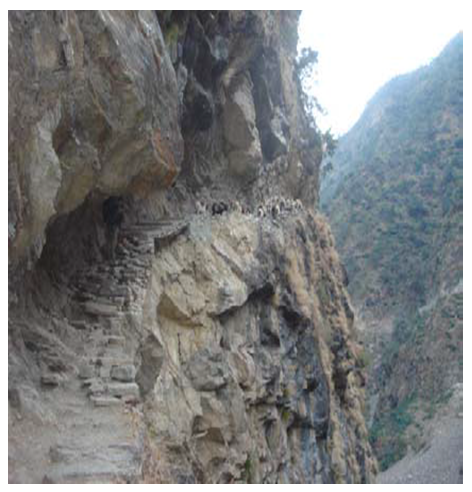 | Figure 2. Hard rock cutting in most of the portion to reach Malkot from Khulalu |
 | Figure 3. Animals are the means of Transportation in project Area at present |
References
| [1] | Ahmed, T. (2016, 8 10). ResearchGate. Retrieved from ResearchGate: researchgate.net. |
| [2] | Alali, F. E., Suliman, S. M., & Al-Shafie, K. (2022). An Investigation into the Delay Factors Affecting the Construction Projects in the Petrochemical Industries in Bahrain. International Journal of Construction Engineering and Management, 21-29. doi:DOI: 10.5923/j.ijcem.20221101.03. |
| [3] | Aziz, R. F. (2013). Ranking of delay factors in construction projects after Egyptian revolution. Alexandria Engineering Journal, 387-406. |
| [4] | Jashaami, M. A. (2021). Improving Delay Management of Construction Projects by Creating a Systematic Scoring Scale to Minimise/Avoid Delays. |
| [5] | kalikot, D. D. (2008). Initial Environmental Examination. District Development Committee kalikot. |
| [6] | Komurlu, R., & Arditi, D. (2021, 10 24). ResearchGate. Retrieved from ResearchGate: researchgate.net. |
| [7] | Muhwezi, L., Acai, J., & Otim, G. (2014). An Assessment of the Factors Causing Delays on Building Construction Projects in Uganda. International Journal of Construction Engineering and Management, 13-23. |
| [8] | Nepal, F. o. (2020). Federation of Contractors Association of Nepal Souvenir. Federation of Contractors Association of Nepal. |
| [9] | Shahsavand, P., Marefat, A., & Parchamijalal, M. (2018). Causes of delays in construction. Engineering, Construction and Architectural Management, 497-533. |
| [10] | Suresh Kumar Chaudhary, J. J. (2022). Comparison of Risk Minimization Strategies in an under Construction Five Star Hotel in Kathmandu Valley, Nepal. Journal of Safety Engineering, 1-8. doi:DOI: 10.5923/j.safety.20221101.01. |
| [11] | Yap, J. B., Goay, P. L., Woon, Y. B., & Skitmore, M. (2021). Revisiting critical delay factors for construction: Analysing projects in Malaysia. Alexandria Engineering Journal, 1717–1729. |





 Abstract
Abstract Reference
Reference Full-Text PDF
Full-Text PDF Full-text HTML
Full-text HTML












